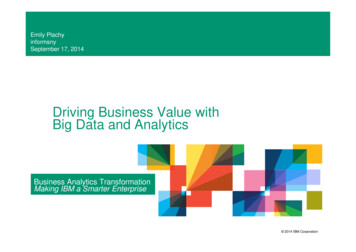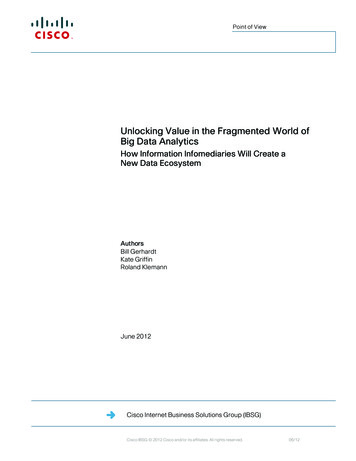
Transcription
Emily PlachyinformsnySeptember 17, 2014Driving Business Value withBig Data and AnalyticsBusiness Analytics TransformationMaking IBM a Smarter Enterprise 2014 IBM Corporation
Agenda Case studies‒ Human Resources: Detect employees that are likely toleave the organization‒ Manufacturing: Optimally schedule work on amanufacturing line‒ Supply Chain: Detect quality problems in manufacturing‒ Finance: Identify risk of acquisitions‒ Sales: Boost effectiveness of sales resource‒ Services: Develop new business Emerging themes Look to the future2 2014 IBM Corporation
Today, applying analytics can make a positiveimpact in all industries.“We believe that analytics is no longer an emergingfield; today’s businesses will thrive only if theymaster the application of analytics to all forms ofdata. Whether your office is a scientific lab, amanufacturing company, a government agency, ora professional sports stadium, there is noindustry left where an analytics-trainedprofessional cannot make a positive impact.” Brenda Dietrich, IBM Fellow andVice President, Emerging Technologies, IBM Watson3 2014 IBM Corporation
Human Resources: Tailored analytics drivenrecommendations reduces attrition of high-valueemployees 85MEstimated net benefit throughreduced attrition in IBM’s growthmarket employee population325% ROIFor 2012-2013 investmentBusiness problem: Employee attrition increases recruitment and training costsand decreases productivity while new employees ramp up. IBM needs a way toidentify employees at-risk of leaving in order to optimally direct resources in aneffort to retain them.Solution components:- IBM SPSS Modeler- IBM Cognos BISolution: Use advanced predictive models to identify employees most at-risk ofleaving and identify the characteristics that put them at risk. Align workforcepolicies to focus resources on high-value at-risk employees.Leverage Cognos to provide HR leaders an aggregate view of which populationsare at risk and what factors are increasing attrition rates. Provide managers risklevels of their respective employees along with employee-specific prescriptiverecommendations to decrease probability of attrition.4 2014 IBM Corporation
Manufacturing: Optimization Research reducesproduction time on manufacturing line.15%Reduction in production timesReduced overhead to adapt tochangesBusiness problem: Scheduling a complex manufacturing process in asemiconductor lab. IBM’s 300-mm fab was one of the first fully automatedsemiconductor plans in the world. A major problem to solve was how to optimallyschedule the lines to maximize overall throughput while taking into accountvariable priorities of the different types of wafers.Solution component:- ILOG Fab PowerOpsSolution: IBM and ILOG worked jointly to use mixed-integer programming andconstraint programming in a special-purpose decomposition algorithm forscheduling of the fab.The software evolved into ILOG Fab PowerOps, a flexible solution forsemiconductor production scheduling.5 2014 IBM Corporation
Supply Chain: Quality Early Warning System(QEWS) – Detects problems up to 6 week earlier 50MCost savings, approximately 10M / yearProactive Quality ManagementImproved Brand ValueBusiness problem: Needed to provide better detection of emerging defects onits manufacturing lines, and identifying true problems and not false alarms.Existing statistical process control (SPC) and rate-based management techniqueswere reactive, and often based on past performance and statistical relevance.Existing techniques were unable to predict what may occur in the future. Warningswere not ranked to focus on potential emerging issues.Preventive Maintenance andQuality 2.0- Quality Early Warning System(QEWS) is now part of PMQ 2.06Solution: Quality Early Warning System (QEWS) uses proprietary IBM technologyto detect & prioritize quality problems earlier with fewer false alarms, coupled withpush alert functionality for IBM & suppliers to proactively detect & manage qualityissues at any stage of product lifecycle. 2014 IBM Corporation
Finance: Identify and mitigate acquisitionrisk by leveraging data and analytics80 Acquisitionsbenefited from headlights intoexecution risks to affect bothdeal pricing and integration planEnd-to-End RiskManagement across theacquisition portfolioStreamlined tracking andreporting to identify systemic riskand address challengesSolution components:- IBM SPSS Modeler, Statistics- IBM Cognos BI- IBM WebSphere7Business problem: Acquisitions ‘synergies’ are challenging to quantify andrealize. Systemic and contextual risks can significantly alter performance &financial expectations.Generally, corporate development business cases and executed contracts don’tcapture the majority of operational risks such as employee retention, systemintegration, sales execution & pipeline management.Solution: Used rich acquisition data (structured and unstructured) and advancedanalytics models to create tailored risk profiles for each contemplated deal andproperly address throughout the acquisition lifecycle. Affects pricing discussions,terms and condition, and post acquisition resource deployment and managementfocus.Note: Similar solution could potentially be applied to Vendor selectionassessment and or ongoing reviews of risk exposure 2014 IBM Corporation
Sales: Boost sales effectiveness by applyingadvanced analytics to align resources to marketopportunity 300Mestimated additional revenueduring 2013 due to sales forceproductivity increase3000% ROIfor 2013, based on a yearlyongoing investment of 10MSolution components:- IBM SPSS Modeler, Statistics- IBM Cognos BI- IBM Netezza8Business problem: Allocation of sales resources is not based on expected returnon expense investment and, thus, suboptimal – also impacting client experience inhigh-potential accounts.Solution: Created advanced analytical models that predict customer profitcontribution based on historic revenue growth and opportunity headroom for everyaccount.Built recommendation engine allowing worldwide sales managers to generate realtime customized reports providing Increase / Decrease / Maintain resource shiftrecommendations at a client level. 2014 IBM Corporation
Services: Develop new business using advancedanalytics and social media MMillions of dollars in increasedrevenue and millions of dollars incost savingsBusiness problem: Developing new business in an existing market, finding newcustomers, finding new products and services for existing customers.Solution components:-IBM SPSS Modeler, Text AnalyticsSolution: IBM Global Technology Services and IBM Research developed theLong-Term Signings Platform. Analyzed over 30 data sources (IBM Connections, LinkdedIn, financialdatabases) to provide 360-degree view of clients; used three types of analytics(entity, text, and predictive) Discovered associations between clients and products9 2014 IBM Corporation
Several themes have emerged from our analyticssolutions. Relationships inferred from data today may not be present in data collectedtomorrow. You don’t have to understand analytics technology to derive value from it. Fast, cheap processors and cheap storage make analysis on big datapossible. Doing things fast is almost always better than doing things perfectly. Using analytics leads to better auditability and accountability.10 2014 IBM Corporation
Best practice Approach to AnalyticsThink bigStart small Perfect data is a longjourney and you can’tafford to wait Organize & cleansedata incrementally sothat projects can startDeliver fastCollaborative To gain business valuestart on analyticprojects right away Have businessanalysts work with dataanalysts Put a stake in theground to progress theproject and get results Review and makeimprovementsIncrementalData Analysts11IterativeBusiness Acumen 2014 IBM Corporation
Big data challenge“The most competitive organizations are going tomake sense of what they are observing fastenough to do something about it while theyare still observing it.” Jeff Jonas, IBM Fellow and Chief Scientist,Context Computing12 2014 IBM Corporation
Several dynamics are underway that are shapingthe future for big data and analytics. Growth of data – 2.5 billion gigabytes generated every day Unstructured data – 80% of big data growth is unstructured (socialmedia, video, audio, images, data from sensors). Cognitive computing – Just when we need it, the third era of computing,cognitive, offers the promise of allowing us to rapidly explore big dataand uncover insights.13 2014 IBM Corporation
- IBM SPSS Modeler - IBM Cognos BI 85M 325% ROI Estimated net benefit through reduced attrition in IBM’s growth market employee population For 2012-2013 investment Human Resources: Tailored analytics driven











